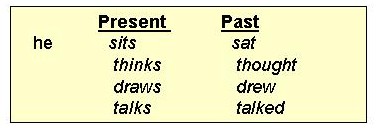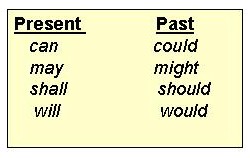|
Self Teaching Unit:
THE VERB EXPANSION RULE
© 2006 Margaret L.
Benner All rights reserved.
The verb expansion rule provides a formula that covers
every predicate verb possibility in the English language.
The entire formula looks like this:
T + (M) + (have + en) + (be + ing) + (be + en) + MV
The items in parentheses are optional items.
The items not in parentheses are necessary for every verb.
MV = main verb
Every verb must have a main verb.
For
example:

T = tense
Every verb must indicate a time. Simple tenses are present
and past.
For
example:

Thus, the simplest form of every verb could be written
using only the essential parts of the verb expansion rule
T + MV (Tense +
Main Verb)
To illustrate the specific verb, we designate the
tense and the main verb:

The tense (present or past) is applied to what follows it
-- in this case, the main verb.
Try Exercise 1 to see whether you
understand this basic part of the verb expansion rule.
Expanding the rule
The rule begins to expand when we add the items in
parentheses. They may be used or not used in any combination. When
used together, however, they must always be used in the order given in the rule.
- You may add a modal auxiliary verb (M) to the
main verb.
This addition expands the smallest form of the verb rule
to
T + M + MV
There are four modal auxiliary verbs with both
present and past tenses.

The modal auxiliary must has no tense designations.
Each part of the verb expansion rule influences what
follows it. Thus, with the modal addition, the tense marker (T) will
designate the tense of the modal auxiliary.
To add a modal auxiliary to the verb, indicate present or
past tense, write the base (present) modal form and follow it with the base form
of the main verb. (When writing the rule, always use the base form of the main
verb and any auxiliary verbs.)


Do Exercise 2 now to make sure that you understand
modal auxiliary verbs.
To add has / have to the verb, change the
form of the verb: Add the -en ending to the main verb.
Thus, the present verb eat becomes has eaten or have
eaten, depending on the subject.

Because adding the auxiliary verb have to the main
verb always requires adding the -en ending to the main verb,
the + - en is included inside the parentheses with have.
(have + -en)
Notes:
1. The verb expansion rule
always uses the generic have, even if the final form will appear
as
has or
had.
2. The -en ending
may not look like -en in the final verb.. The -en ending is used to designate
all endings that are used with the auxiliary verb have. (e.g. has sat,
have thought, had
drawn, have talked)
Now the rule expands to include have +
en:
T + have + -en + MV
As before, the tense designation (T) is
applied to whatever follows it. In this case, that will be the auxiliary
verb have.
In addition, now the -en ending (have + -en) will apply to
whatever follows it. In this case, that will be the main verb.

Click on
Exercise 3, where you will add have + -en to the main verb.
If both a modal auxiliary and have + en are
used with the main verb, the verb expansion rule expands to
T + M + have + -en + MV
The tense designation is applied to whatever
follows it -- in this case the modal auxiliary.
Examples:

Do Exercise
4 to check your understanding.
To add be to the verb, change the
form of the verb: Add -ing to the main verb.
Thus, the present verb eat becomes is eating, are
eating, was eating, or were eating.

Because adding the auxiliary verb be to the main
verb always requires adding the -ing ending to the main verb,
the + - ing is included inside the parentheses with be.
(be + ing)
Note: The verb expansion rule always uses the generic
be, even if the final form will appear as is, are, was, or were.
Now the rule expands to include be + ing:
T + be + ing + MV
As before, the tense is applied to whatever
follows it. In this case, that will be the auxiliary verb be.
In addition, now the -ing will apply to whatever follows it. In
this case, that will be the main verb.

Do Exercise 5 to see how well you
understand the addition of be + -ing to the main verb..
If both a modal auxiliary and be + ing
are used with the main verb, the verb expansion rule expands to
T + M + be + -ing + MV
The tense designation, along with the -en
and -ing endings, should be applied to whatever follows each one.
Examples:

If a modal auxiliary, have + en,
and be + -ing are used with the main verb, the verb expansion rule
expands to
T + M + have + -en + be + ing + MV
Again, the tense designation, along with the -en
and -ing endings, should be applied to whatever follows each one.
Examples:

Go to Exercise 6
to
check your understanding so far.
Adding be + -en to the main verb will make
the verb passive.
This change will mean that the subject of the sentence will not do the action
of the verb; instead,
the subject will be acted upon.
Now the rule expands to include be + -en:
T + be + -en + MV
Here too, the tense designation and the -en
ending apply to whatever follows them.

Try Exercise 7
to check your understanding of the
passive be + -en addition.
The passive be + -en option may be used with any other optional part of the
verb expansion rule.
Examples



Now do Exercise 8.
If all of the other optional parts of the verb expansion
rule are used with be + -en, the verb expansion rule expands to its full
potential.
Examples

These examples show the full expansion rule at
work:
T + (M) + (have + en) + (be + ing) + (be + en) +
MV
Click on the Post
Test to see how well you understand the Verb Expansion Rule.
|